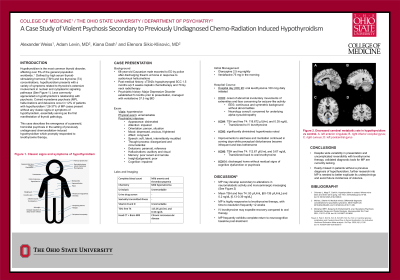Psycho-Oncology and Palliative Care
(117) A Case Study of Violent Psychosis Secondary to Previously Undiagnosed Chemoradiation-Induced Hypothyroidism

- AW
Alexander Weiss
Medical Student
The Ohio State University
Dublin, Ohio 
Adam Levin, MD
Resident
The Ohio State University
Columbus, Ohio- KD
Kiana Dash, n/a
Medical Student
Ohio State University College of Medicine
Columbus, Ohio - ES
Eleonora Sikic-Klisovic, MD, MSc, DFAPA
Associate Professor Clinical , CL Psychiatrist
Department of Psychiatry, The Ohio State University Wexner MC
Columbus, Ohio
Presenting Author(s)
Co-Author(s)
Background/Significance: Hypothyroidism is a highly treatable cause of new-onset psychosis which is often overlooked (McKee, 2016). Myxedema psychosis (MP), hallucinations and delusions secondary to low thyroid hormone, occurs in almost half of patients with hypothyroidism (Mohamed, 2021). Notably, 26-37% of MP cases present without any classic signs or symptoms of hypothyroidism, essentially serving as the first manifestation of thyroid pathology. Hypothyroidism’s connection to psychosis is poorly characterized in scientific literature however. This case study describes the emergence of a paranoid, homicidal psychosis in the setting of previously undiagnosed chemoradiation-induced hypothyroidism which promptly responded to levothyroxine therapy.
Case: A 68-year-old Caucasian male was escorted to the emergency department by police officers after discharging a firearm at his home in response to threatening hallucinations of his late wife and her “new boyfriend.” His hallucinations were accompanied by paranoid delusions and ideas of reference. Two months prior to his presentation, he underwent a 5-week course of cisplatin chemotherapy with 70 Gy neck radiotherapy treatments for hypopharyngeal cancer. Work-up was pertinent for thyroid stimulating hormone elevated to 115.05 uIU/mL and free thyroxin depressed to 0.34 ng/dL. His psychosis was initially refractory to olanzapine 2.5 mg but quickly improved 24 hours post-intravenous levothyroxine initiation with normalization of thyroid labs. Ten days after induction of intravenous levothyroxine, he displayed no residual signs of cognitive dysfunction or psychosis.
Discussion: In this case, hypothyroidism induced by cisplatin augmented neck radiotherapy provoked severe psychosis leading to violent behavior. The National Comprehensive Cancer Network recommends routine thyroid function screening every 6-12 months after undergoing neck irradiation (Pfister, 2024), but radiotherapy induced hypothyroidism can develop before this initial screening (Fujiwara, 2015). While inadvertent injury was narrowly escaped in this case, it may be prudent to emphasize earlier initiation of thyroid studies in patients undergoing neck radiotherapy.
Conclusion/Implications: Hypothyroidism-induced psychosis is easily diagnosed and treated but is relatively rare and therefore often overlooked. Given that MP is not always associated with classic signs and symptoms of hypothyroidism, suspicion should be high in those with any risk factors for hypothyroidism, including recent head and neck irradiation. Future research might focus on developing better diagnostic tools for MP and on elucidating the underlying pathophysiology.
References:
1. McKee J, Brahm N. Medical mimics: Differential diagnostic considerations for psychiatric symptoms. Ment Health Clin. 2016;6(6):289-296. doi:10.9740/mhc.2016.11.289
2. Mohamed MFH, Danjuma M, Mohammed M, et al. Myxedema psychosis: Systematic review and pooled analysis. Neuropsychiatr Dis Treat. 2021;17:2713-2728. doi:10.2147/NDT.S318651
3. Pfister D, Spencer S, Adkins D, et al. Head and neck cancers, version 3.2024, NCCN clinical practice guidelines in oncology. National Comprehensive Cancer Network. Published February 29, 2024. Accessed March 6, 2024. https://www.nccn.org/professionals/physician_gls/pdf/head-and-neck.pdf
4. Fujiwara M, Kamikonya N, Odawara S, et al. The threshold of hypothyroidism after radiation therapy for head and neck cancer: A retrospective analysis of 116 cases. J Radiat Res (Tokyo). 2015;56(3):577-582. doi:10.1093/jrr/rrv006
Presentation Eligibility: Not previously published or presented
Diversity, Equity, and Inclusion: Ageism is an under-recognized unconscious bias held by the medical community. Geriatric complaints frequently go ignored on the grounds of age-related stereotypes, while also sharing intersectionality with other forms of discrimination. Our case reflects the experience of an elderly patient nearly disenfranchised from comprehensive medical care. One factor that could have changed outcomes in our patient is digital inclusion, given age-related technological barriers to accessing their medical provider and health information. Our presentation discusses the importance of clinical curiosity centered around recognizing unconscious bias and facets of systemic discrimination that impact evaluation and care of elderly and mentally ill populations.

